| ANDROS
Andros is the most northerly Mediterranean island in the Cyclades. The island has an area of 38 square kilometres. The coastline is 178 km in length, the island is 41 km long and it varies in width from 6 to 17 km. The island is 7 nautical miles from Evia, from which it is separated by the narrow Channel of Cavo d'Oro. It is very close to the Island of Tenos, from which it is separated by a very narrow channel of about 3.4 nautical miles.The island is connected daily to Rafina, 37 nautical miles away, by ferry boat from Gavrion (almost a two-hour trip). Andros is one of the most beautiful islands in the Cyclades, exposed
to strong winds, with a dry mild healthy climate. The Chora of Andros
is the capital of the island, with about 9000 inhabitants. King Minos handed over the island to his brother Radamanthes, who appointed Andros as its ruler. Pelasgians and Ionians inhabited the island subsequently. The island experienced a new period of prosperity during the Medieval Period during the years of the Byzantine Empire. It became the object of a feud of the Venetians, handed over to Marinos Dandalus. There are numerous monuments and castles on the island going back to this era. It was later conquered by the Turks and occupied by them until 1821,
when the clergyman and philosopher Theophilus Cairis declared the outbreak
of the Greek Revolution. Andros is referred to by various names during
antiquity including: Atandros, Nonagria (wet valley), Epagris, Lavia
(thick vegetation) and Hydrousa ( because of its abundant water resources).
The Mycaenean finds in the island go back to 1500-1000 BC. The Ionians
settled Andros in about 2000 BC. It experienced its highest peak during
the Geometric Period, which lasted from 900 to 700 BC (Zagora), the
island's prosperity (Paleopolis) having continued ever since then. Apikia, a beautiful Mediterranean village in an evergreen environment with abundant water resources, is located four kilometres to the SW of Chora. The famous therapeutic springs of SARIZA are also found here. You can see the Monastery of Ag. Nikolaos (18 Century), which houses worthwhile works of art 9 km to the East of the village. The Village of Mesaria, which was the center of the island during the Byzantine period because of its strategic position, is located by the central motorway 5 km to the SW of Chora. Do visit the Church of Taxiarches (1158 AD), built by the Byzantine emperor Michael Komnenos, with its wonderful statues and its worthwhile reredos as well as the tower of the Cairis family. Menites is the Mediterranean village located in a beautiful all-green environment with abundant waters 5 km due West of Chora, priding itslef on the water spring of DIONYSOS. Stenies is a beautiful, thickly-vegetated Mediterranean village with a wonderful view of the Aegean Sea 7 km to the East of Chora. The Epano Castro (Upper Castle) or Paleocastro (Old Castle) or Castro tis Grias (Old Woman's Castle), was erected during the first years of the Venetian occupation, at the village of Cochylos 15 km to the South of Chora by the central motorway leading to the Bay of Corthion. Palaeopolis is the ancient capital of the island, located 16 km to the West of Chora and on the Western side of Mount Petalos. Many significant archaeological finds like ancient tombs, mosaics and the famous statue of Hermes - a masterpiece ascribed to Praxiteles (Archaeological Museum of Andros) - have been found here. Visit the area of the ancient market of Zagora, going back to the Geometric Period (8th Century) with significant finds and ruins of the Cyclopeian wall, which is one of the most significant archaelogical sites on the island near the Village of Zaganari, 16 km to the West of Chora. Arna is a Mediterranean village surrounded by a sublime green landscape, located 18 km to the East of Batsi. Visit the Monastery of Agias on the side of Mount Petalo. The beautiful seaside village of Ormos, with its tourist infrastructure and its beautiful beaches, is 19 km due South of Chora. The Byzantine Abbey-citadel of Panachrandos, built by Nikiphoros Phokas in 961 AD, rises in Fallica and on the side of Mount Gerakones 20 km to the South of Chora. Batsi, located 27 km to the SW of Chora, is one of the first settlements in Andros, offering a fascinating picture: wonderful clean beaches and a very advanced tourist infrastructure. It is one of the island's best summer resorts. You should also visit the Monastery of Zoodochos Pigi (14th Century) with its numerous, important heirlooms and manuscripts. Gavrion, the royal harbour of Andros with its beautiful beaches and
its sophisticated tourist infrastructure, is located 31 km to the NW
of Chora. You should visit the tower, going back to the Hellenistic
Period, of a truncated conic shape, in Agios Petros (St.Peter). 2. The Archaeological Museum, which is a donation of the Goulandris family, with numerous archaeological finds. Admire there the statue of Hermes, which is thought to have been carved by Praxiteles. 3. The Museum of Modern Art, exhibiting very beautiful works by the Andrian sculptor Michalis Tombras. 4. The church of Panagia (Virgin Mary) of Palatiani, with a remarkable carved wooden reredos. 5. The Church of Panagia of Theoskepasti, with a sublime carved wooden reredos and the Church of Agios Georgios. (Saint George). 6. The beautiful Chapel of Panagia of Thalassini at the port's old loading wharf (Plakoura). 7. The Nautical Museum with its rich collection of model ships. 8. The ruins of the fortified citadel at the end of the town as well as the Square of Afanis Naftis (Unknown Sailor), sporting a work made by Michalis Tombras. 9. The Empirikion Gymnasion of a remarkable architectural style and
the Empirikion Geriatic Asylum. As you can see, there are three famous buildings here, adorned with a facade consisting of columns in the Greek Style: one of these buildings houses today the headquarters of the Greek Police and the other, which is almost opposite the former, is a neoclassical building used to house the headquarters of the Greek Electricity Company, while the third one houses the CAIRIO (established by Th.Cairis) Library. Walking past, observe now on your right and on your left the well-preserved buildings, admiring next the Empirikio High School, which today houses the Nautical Museum. Then, we see the Club of Andrians (Leschi Andrion) with its garden. Here, you can expect to be welcomed in a civilized environment and to be informed, if you wish, about the cultural prehistory of the Philologon Somation (Literary Association). We have reached the large square of the Geriatric Institution, which bears the name of Vassilis Goulandris, the important Andrian ship-owner, since its tile-paving was constructed at his expense. The Heroon (the Column for Heroes) rises, as you see, in the middle of the square in honor or the brave Andrians who were killed in battlefields fighting heroically. The Empirikion Geriatric Institution and Hospital, which was built in 1894 in the Archaic Style and which houses also the Health Service Headquarters in Andros, are found in the SE section of this square. From the Goulandi Square, let us walk down slowly along Georgiou Constantinou Empirikou central road; to the right and left, as the signs reveal, there are two chemists' laboratories on the ground floors of two mansions. Then you can see clothing and food department stores, over which there are very well-preserved or restored buildings constructed according to the native traditional insular architecture. You will arrive, about one hundred metres further on, at the branch of the Ionian Bank on the right side of the road and, above it, the Aegli Hotel. The tree planted all-green garden on the right side of the road belongs to the parish Church of the Kimissis of Theotokos, rising aloft with Christian vividness. Then we arrive in the square where the inhabitants of Andros erected the marble effigy of Theophilus Cairis, in honor of the famous revolutionary of the liberation struggle of the nation against the Turks in 1821. One side of this square is adorned by a picturesque marble font (Krini) and by the famous Archaeological Museum of Andros. This fond was built, as the inscription on its front tells us, in 1818. The Archaeological Museum of Andros is simple and austere externally as a building, donated by the native shipowners Vassilis and Peter Goulandris and by Elisa Goulandris. The Museum is regarded as one of the best museums of modern times in the Balkan Peninsula, and it houses all the Andrian archaeological finds as well as the sublime statue of Hermes of Andros.
Photos © Ian Swindale Copyright: Hellenic Electronic Center Back to Cyclades Islands |
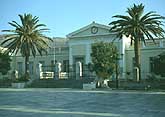
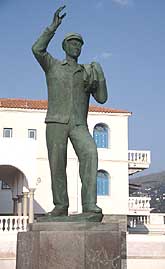
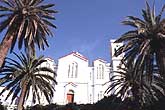
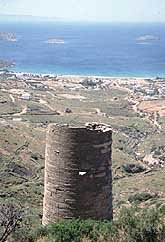
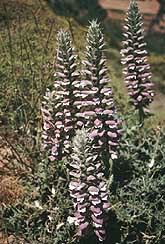
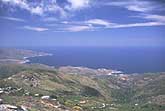
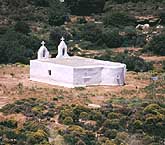
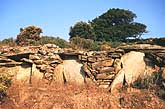
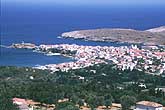
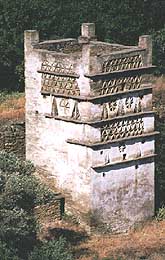
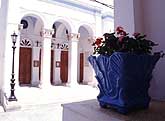
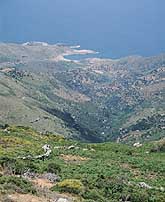

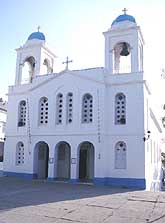
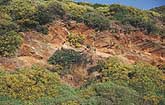
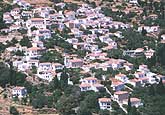
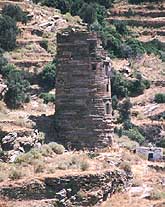
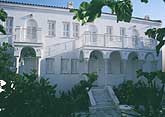
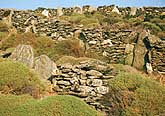
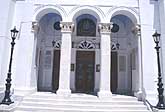
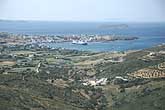

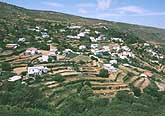
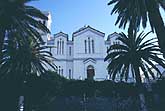
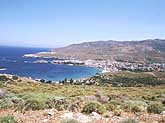
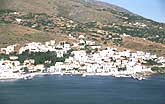
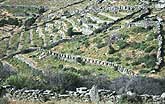
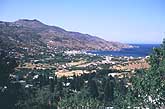
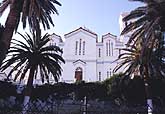
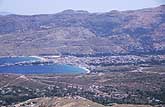
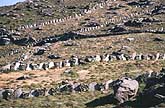

 |
|